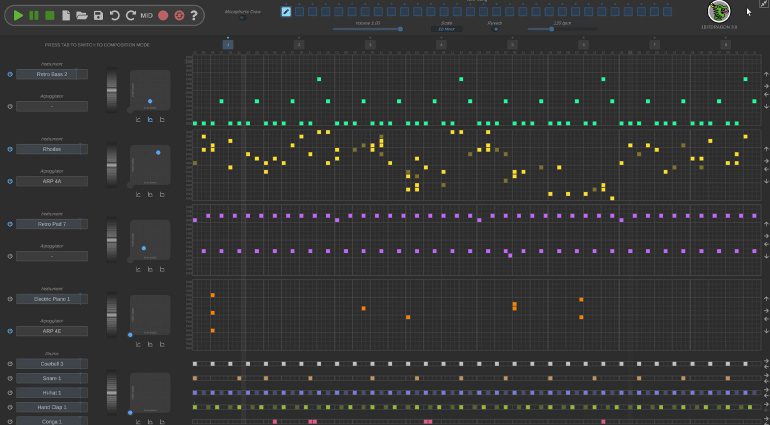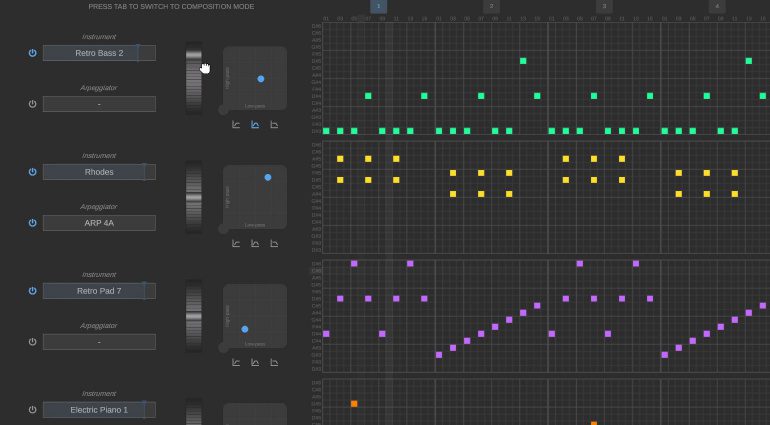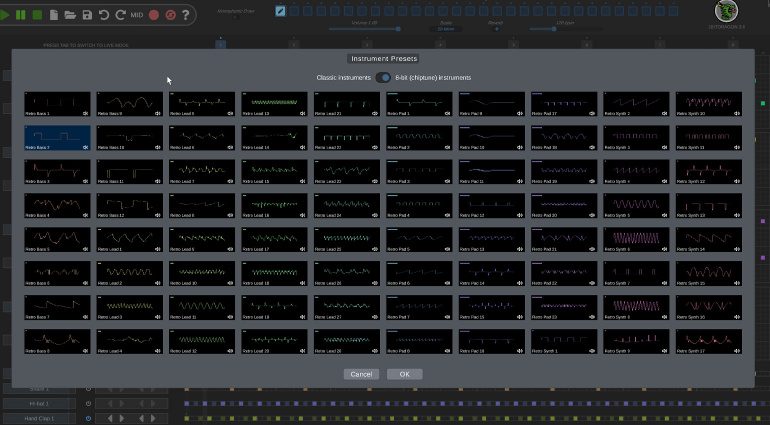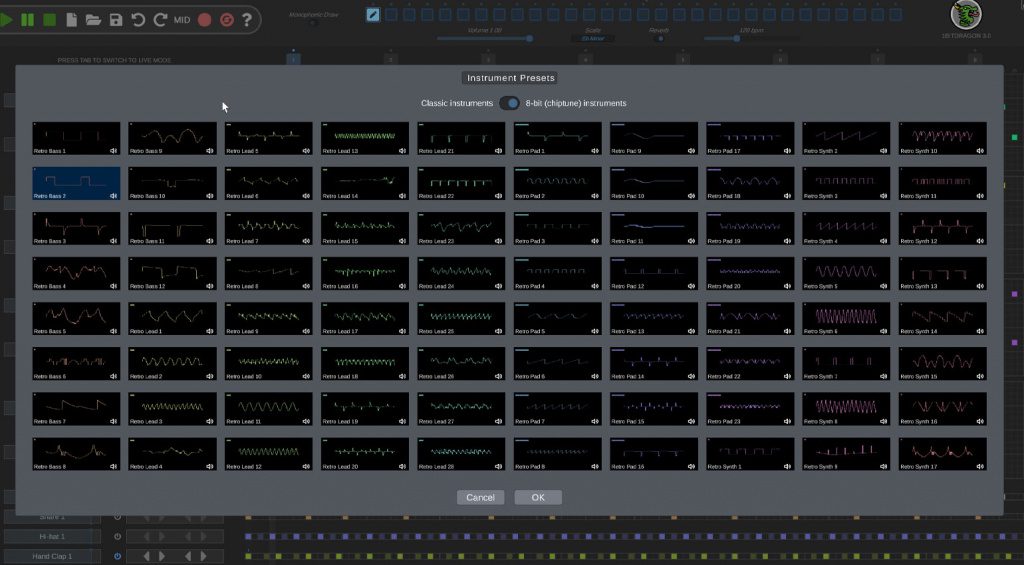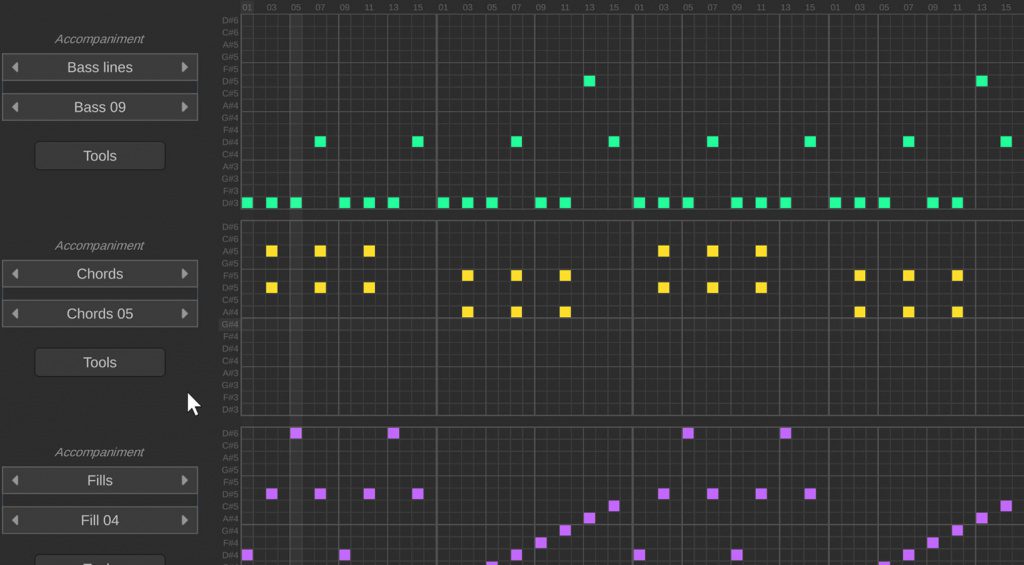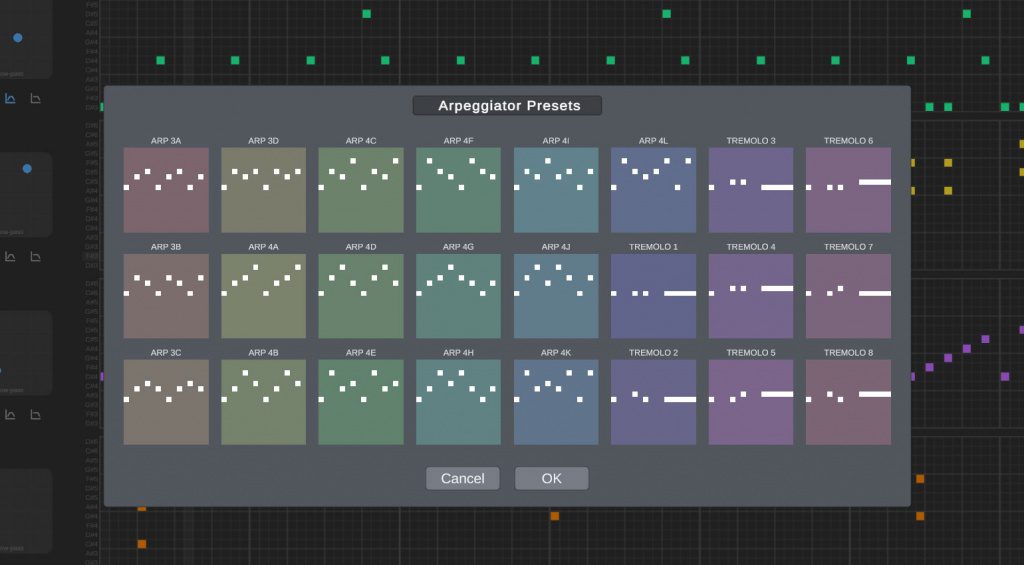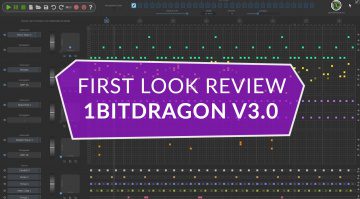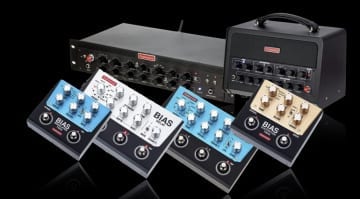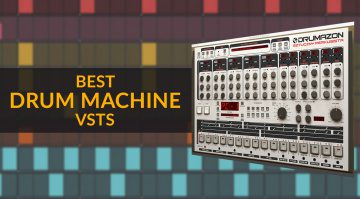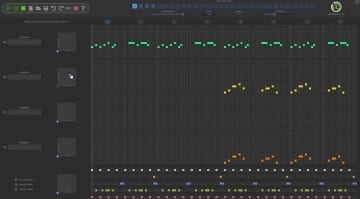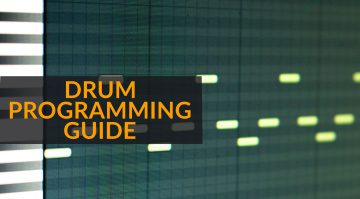First Look Review: 1BitDragon 3.0, a standalone grid-based music making machine
Depth and complex versatility can be overrated when you want to make some music. While some people enjoy the minutiae of carefully crafted composition, 1BitDragon offers another approach that is ridiculously easy to get into, completely self-contained and can produce some pretty decent tunes.
Getting started
1BitDragon is a 4-channel melodic and 5-channel percussive music generator based on a grid or matrix style sequencer. It’s purely mouse-driven, you’re not having to worry about playing a keyboard or trying to hit the right notes, you just build patterns of coloured squares in the hypnotic looping of the grid. Each bar offers a grid of 16 notes against 16 pentatonic pitches covering 3 octaves of the chosen scale. Set the sequencer in motion and you left-click to add notes and right-click to remove them. It’s so easy.
You are currently viewing a placeholder content from YouTube. To access the actual content, click the button below. Please note that doing so will share data with third-party providers.
Each grid extends for 8 bars giving you up to 128 steps for a sequence. These are known as a block and you can have 30 blocks in a song. You can loop any number of bars and even jump between bars with a click like launching a clip or a scene in Ableton Live and always stay in sync.
Once you have a handful of notes on the grid there are some useful tools available to move them and mess them about. On the far right of bar 8 are some arrows. These step the whole pattern up and down the grid in pitch or forwards and backwards a step at a time. Under the Tools button you can fill in some notes with arpeggiation, Flip them about a horizontal axis, Shuffle the notes which makes very small changes or randomise which completely replaces your notes with something randomly generated over all 8 bars – use with caution.
That’s the basic premise of 1BitDragon; grid sequencing with a bit of manipulation, but from there developer Nicolas Morin has built-in a load of music-making tools to help you shape your ideas into music.
Sounds
1BitDragon is completely self-contained and comes with its own instrument sounds and drum kits. There are 175 regular sounds covering things like bass sounds, pianos, harps, effects, organs, strings, synths and voices and each of the 4 tracks can have its own sound. These are made from Open Source samples and SoundFonts – they’re OK in a General MIDI kind of way but don’t have any editable parameters. Some of the sounds have variations with longer release times so you can have sustained notes instead of the single blips normally associated with grid sequencers.
However, with a flick of a switch, you can access the 8-bit chiptune instruments and these are a completely different experience. This is a library of 80 simple synth waveforms covering bass, lead, pad and synth and they sound great. These should be the default bank, not the regular instruments – now my tune is getting interesting.
On the drums and percussion side, there are 150 regular drum sounds mixing acoustic and classic electronic sounds and 125 chiptune tones. The chiptune sounds are a bit more specifically 8-bit arcade in style so the regular drums are very useful to have.
Accompaniment
If clicking in the grid has not brought you the inspiration you hoped then help is at hand with the Accompaniment section. These are preset note patterns with which you can fill your grid. You can choose from Bass Lines, Chords, and Fills and each one has 30 variations. With a few clicks you can throw together a bassline and some chords plus the odd fill and it all hangs together pretty well. They are completely usable and inject a lot of instant music pleasure into the whole process, particularly if you don’t know where to start.
One snag is that you have to click through each variation one at a time. I’m sure in version 2 a window came up listing all the variations and you could choose one, just like does when choosing sounds or Arpeggiators (which we’ll come onto in a minute). I think this is probably an oversight as it would be much better to be able to select these things directly.
The other thing to watch is that as soon as you enable Accompaniment it will replace whatever is on that grid and so get ready on the Undo button if you don’t want to lose your work.
Arpeggiator
While you have an arpeggiator function under the Tool button which adds notes to your grid there’s also a separate Arpeggiator that uses the notes on the grid to generate arpeggiation without replacing them. You have 24 different presets which pop up and show you what they are in a window so you can select one. These are really quite good and offer a lot of less intentional variation as opposed to the direct notes of the Accompaniment.
Drums
At the bottom you have a drum kit made of five drum sounds and a single line sequence for each one. You can click to add notes to the sequence by hand. But more interesting is to make use of the Euclidean Rhythm Generator. Each drum track has a Primary and Secondary beat generator. As you click on the left and right arrows you step through different Euclidean patterns. Primary beats put in the main thrust of the pattern whereas Secondary beats fill in at a lower velocity. It’s a brilliantly simple and effective rhythm generator.
Live Mode
Live mode is a separate mode that changes just a couple of things. It swaps out the Accompaniment and Toolbox for an XY pad, multimode filter and a mod wheel for applying real-time effects. The filter can be high, low or bandpass and you control the point on the XY pad with your mouse. This works well enough although there’s no automation so you can only do it manually to one track at a time.
The Mod wheel is slightly strange. It appears to also control the filter on the downturn and then does some quite nasty bit crushing on the upturn.
In Live Mode you do a whole performance of your song, swapping patterns, looping sections, muting and soloing parts and playing with the filter and mod wheel and have it recorded to a wave file live. It’s a pretty cool way of capturing your music.
What’s missing?
As I said, 1BitDragon is self-contained and in the context of being a simple, easy-to-use, music-making fun box then it does the job nicely. It has the feel of an iPad app on a desktop computer. However, it’s difficult to see it as anything other than a fun music-making app because of the things it doesn’t do or have. There’s no MIDI support either for controllers or for routing out to external gear. There’s no choice over the audio engine, it just uses whatever is set up as the default in Windows. There’s a global reverb but there are no effects to use on the sounds, there’s no automation, no editing of the instruments and no support for VST plugins or instruments.
From that point of view, not a lot has changed since version 2. I had hoped that this new version would open 1BitDragon up to the world of MIDI beyond the import/export of files because it’s a decent compositional tool that could be a fabulous way to sequence your hardware synths or modular. A few effects would be nice; the ability to add a delay would greatly enhance the sound possibilities. An automation track for the filter or some LFOs for modulation would be great. I’d like to dig into those included sounds just a little bit to tweak them. Or maybe could we drop in our own samples?
Conclusion
1BitDragon is fun and engaging and capable of helping you generate all sorts of music. I’ve always loved a grid sequencer and this one comes with some useful tools that make composition really easy and I find them a joy to use. For me, the massive potential of the grid feels trapped within the limitations of the included soundset. If it had MIDI and a bit of recordable automation it could be a superb laptop-based sequencer for a hardware setup. Adding support for VST Instruments would also elevate it to a whole other level but I imagine that’s no easy task.
Until then it will remain a lot of fun and a fantastic way to play with music-making on a computer with no other gear.
1BitDragon is £20 and is available on Windows and macOS.

